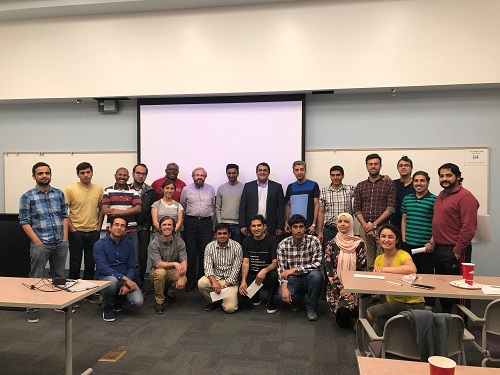Recent News
CHTM Joins NSF's NQVL Pilot Projects
August 9, 2024
OSE PHD, Dr. Xuefeng Li - Wins The Outstanding Interdisciplinary Graduate Programs Award
May 10, 2024
Dr. Ali Rastegari - 2024 OSE Best Dissertation Award Winner
May 10, 2024
2024 OSE Spring and Summer Graduates
May 10, 2024
News Archives
SPIE UNM Student Chapter Held Student Pitch Competition
April 30, 2019

Judges, moderators, and all competitors
On April 10th, the SPIE UNM student chapter held a student pitch competition at CHTM. The event was a competition for students from Electrical & Computer Engineering (ECE), Optical Science& Engineering (OSE), Physics & Astronomy (PandA), and CHTM. Each student had 3 minutes to pitch an idea, product, or research and the panel of judges scored them based on presentation, content, and how that worked overall.
The panel of judges included Professors Marek Osinski, Arash Mafi, and Ganesh Balakrishnan. Seventeen students in total attended the event as competitors. Even moderators were CHTM’s Nazanin Mosavian and Farnood Mirkhosravi. The students were competing for the grand prize of $200. Second place received $125, and third place received $75. An additional $50 prize went to a winner determined by the audience.
The first place winner was Hamed Kookhaee, second place was Saeid Rostami, and third place was Preyom Dey. Winners selected by the audience were Akram Eremadiamin, Mostafa Peysokhan, and Grant Heileman. Here are the top winners pitches:
Hamed Kookhaee
A novel application for Super Absorbent Polymers (SAP)
Super Absorbent Polymers (SAP) have been around for about a century now and the can absorb liquids up to 400 times of their own mass, which is amazing! This absorption is reversible, it means they can release the absorbed liquid under certain conditions, which makes them even more interesting! They have so many applications in different areas. They can be used in dippers, wound dressing, surgical pads, watering the plants, making artificial snow, and even for magical effects! Here, I’m proposing a novel application for these amazing polymers.
Waste disposal always has been a serious issue for the environment. If you stack trash somewhere and give it time, which is the case most of the times, a liquid will collect on the bottom of the trash which is called trash juice and it is a big problem in waste disposal. I’m proposing to use SAP in the bottom of huge trash cans (like the ones you see on streets) or more importantly in waste disposal sites to absorb trash juice. Now what do we do with these polymers filled with trash juice? It turns out trash juice has advantages as well and it’s a strong fertilizer for soil. Problem solved! We can use SAP to solve trash juice problem and turn it into a very useful product for agriculture.
Saeid Rostami
How Science Goes Wrong?!
In this 3 minute pitch competition, I talked about the problems with the academic research. I tried to convey the message by describing the issues with the obligation of “Publish or Perish” which has come to rule over the academic life as a result of competitiveness in science and careerism. I also talked about “the need for verification of published results (Trust but Verify!)” and “failure to report failures (Negative Results!)” which squander money and the efforts of researchers all over the world. Finally, I talked about the solutions such as tightening the standards, providing access to the trial data, allocating space (by journals) and money (by grant-givers) to “uninteresting works”, and post-publication evaluations etc.
Preyom Dey
Resolution Enhancement for Optical Microscopy
A current resolution limit in optical microscopy is around 500nm and is a fundamental barrier. Using imaging interferometric microscopy technique allows us to extend resolution below 100nm for conventional optical microscopy. Extending this resolution will be beneficial to nano-manufacturing processes. This microscope can be used as an at-line metrology tool for nano scale device measurement. This can be helpful in biological research.

From left to right: Prof. Marek Osinski, Prof. Ganesh Balakrishnan,Prof. Arash Mafi, Hamed Kookhaee, Saeid Rostami, and Preyom Dey.


